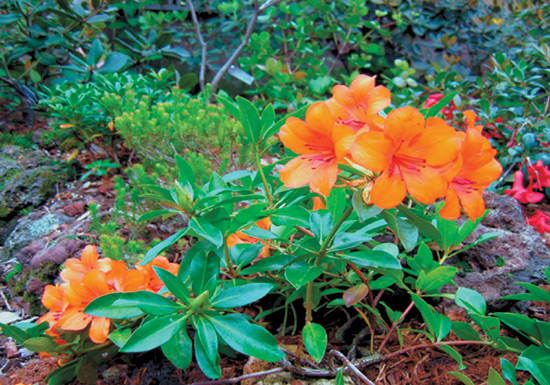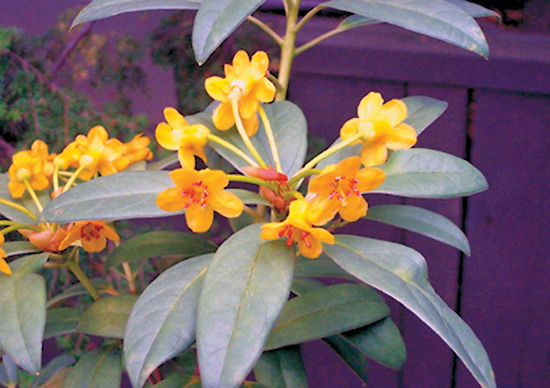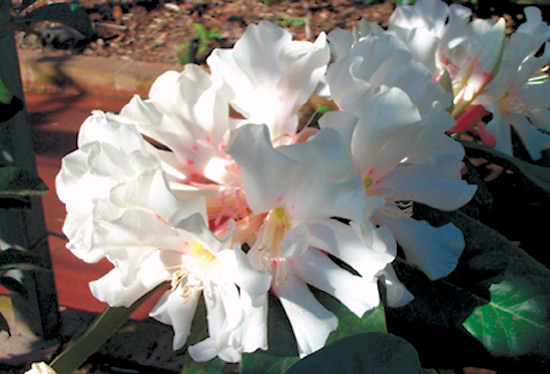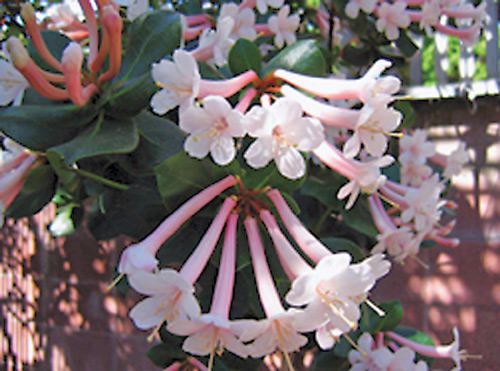JARS v59n4 - A Vireya Display Garden, Lakeside Park, Oakland, California
A Vireya Display Garden, Lakeside Park,
Oakland, California
William Moyles
Oakland, California
In early 1995 I was offered the opportunity to install a vireya rhododendron garden in a sheltered outdoor lath area in Lakeside Park in Oakland, California. I had a growing collection of vireyas and this particular space was "open for (re) development." Barbara Campbell (an active American Rhododendron Society organizer) had been poking away at the local Park and Rec folks to use this site and encouraged me to take a look. I did, and it seemed to me ideal. Vireyas are with few exceptions frost tender, and the sad stories of losses when grown out in full exposure in this area are pretty well known. This site seemed worth taking the chance.
I had slowly built a sizable collection without actually trying: they are really quite easy to grow. Managing a Vireya Seed Exchange for several years gave me access to many unique collections. And, of course, friends and cutting exchanges all contributed. The results were lots of plants, some quite rare and really no place to safely put them.
For readers of this journal it is probably unnecessary to tell you that the almost 300 vireya species make up a sizable portion of the Rhododendron genus. They are semitropical, often epiphytic and come mostly from the mountainous regions of Malesia with warm days and cool to cold nights. For the hobbyist they are the most varied, colorful and fragrant plants in the genus. What does bear repeating and emphasizing is that they are not frost tolerant: they are tender. And that has always been our problem.
The San Francisco-Oakland Bay Area offers borderline frost protection and this has lulled many into complacency but Hawaii we are not. Temperatures in the low 30s F for short periods are common and tolerated...what’s a little foliage damage? Temperatures dropping into the 20s spell disaster and, though rare, do occur. As a consequence vireyas are rarely garden plants here and outdoor public plantings uncommon. Vireyas are difficult to find in local nurseries even though they can be grown with modest protection - certainly easier than moving to Southern California or Hawaii!
Such a shame not to be seen. This relative invisibility was a good part of the reason for taking on Lakeside. The garden now contains over seventy quite visible plants with room for perhaps fifteen more. Many are reaching 6 feet.
All are growing in raised beds under 50% lath in an enclosed area of around 50 by 70 feet. Open yet protected; secure and lockable. Hopefully with this modest bit of protection they will survive. The watering is automated. Summer temperatures range mostly from the high 60s to high 80s F. Vireyas are kept on the "just moist" side with morning watering for 15 minutes every three days. The system is turned off during our November to March rainy season. During this period average temperatures range from the 40s to mid 50s F.
The challenge at Lakeside was to create a garden that was aesthetically pleasing and interesting even though it contained predominately one genus. It is fundamentally a public garden. Given the amazing diversity available within the section Vireya , I believe we have met the challenge. What we have now is a broad mix of species and hybrids including a selection of species not generally seen in cultivation.
Diversity can easily become the buzzword for vireyas. If in doubt one needs only to log into Chris Callard’s vireya website: www.vireya.net - a true labor of love, and probably one of the best informative sites of a single plant genus on the Internet.
At Lakeside this diversity ranges from major large hybrids to alpine and summit loving dwarfs. Two of the beds are raised to 4 and 5 feet (complete with rocky summit) in order to display the smaller scrambling and mat forming things. Figure 1 shows the orangey Rhododendron acrophilum with R. ericoides background left. Rhododendron ericoides is from wild collected seed at 13,000 feet, Kinabalu, Sabah, by David Binney, New Zealand. Rhododendron acrophilum is from the Royal Botanic Garden Edinburgh seed exchange material collected on Mt. Mantalingajan, Palawan Island, in the Philippines. In the same bed are several hybrids involving the mat forming New Guinea species, R. saxifragoides . Our only plant of the species is much too small to plant out without fear of it "disappearing." Only recently has R. acrophilum come into cultivation and it is a prime candidate for hanging baskets.

|
|---|
Figure 1. R. acrophilum and R. ericoides Photo by William Moyles |
At Lakeside we have not as yet pursued hanging basket culture, but we will if only out of necessity as we run out of space in the raised beds.
We are amazed at the response of these plants when released from the confines of their containers and their roots allowed to spread into the beds. Wispy plants perk up ( R. ericoides was one) and hybrids just take off. This is not to say that vireyas cannot be container grown: they can be and grown well, but as one used to growing vireyas in containers it is exciting to see them develop under open conditions. I feel that one of the most significant factors in growing vireyas well is maintaining a cool root system - cool roots and a quick draining medium - often difficult to achieve in containers which hold moisture and absorb heat. Not so in open beds.
Over the past decades I’ve been fortunate to observe, and learn from, the experience of others using similar raised-bed culture: Peter Sullivan at Strybing and now his church garden in particular; the (late) Evans’ garden in Oakland, and others. Vireyas are planted much like Maddenias in loose organic duff on top of and not in the ground. The beds at Lakeside incorporate at least 35% coarse lava rock (1/4 in. to 3/4 in. particle size) along with coarse fir bark, redwood "fur" and whatever organic "junk" is around - at least 85% "soil-less." The big hybrids get a somewhat looser mix and the high altitude alpines a denser more compact mix. All get a periodic weak foliar feed and drench with a balanced organic fertilizer.
A distinct advantage at Lakeside is the possibility of displaying new and unique things. In 1993 seed was received from Linda Wylie (ARS Seed Exchange) from Alan Clark’s 1992 N.W. Vietnam collection. Included was AC 374 (unidentified vireya) which subsequently turned out to be a new species now named R. rushforthii . Plants from this collection are in Lakeside (see Fig 2). We also have examples of Clark’s Vietnam collection of the compact buttony-leaf R. emarginatum (syn. R. euonyfolium , R. poilanei ex. G. Argent, unpublished).
Rhododendron rushforthii is attractive with unique foliage, but more importantly it has proven hardy in some parts of the British Isles. Rhododendron rushforthii is closely related to the Taiwanese species R. kawakamii , which has proven to be hardy into the teens. There are few hardy vireyas and Jim Gerdemann in Yachats, Oregon, is working on the problem. Lakeside has an example of R. ‘Lawrence’, Peter Sullivan’s cross of R. viriosum (formerly R. lochiae ) and R. commonae . ‘Lawrence’ has survived temperatures into the low 20s F and is included in Gerdemann’s breeding program. We will see how R. rushforthii fares.

|
|---|
Figure 2. R. rushforthii Photo by William Moyles |
Lakeside has turned into a place to really show off! Many years ago the ARS Vireya Seed Exchange received from the late John Rouse (Australia) seed from a cross of a Lyn Craven’s select R. konori ‘White Giant’ and R. leucogigas ‘Hunstein’s Secret’. It has proved outstanding - huge fragrant trusses, great vigor and large felted foliage. Strybing Arboretum named one selection after the late Karen Morebeck, the woman who along with Jack Spring literally saved vireyas from extinction at the arboretum. Mitch Mitchell in Hawaii named one after his granddaughter Marni (as ‘Sweet Marni’), and here at Lakeside we are growing an unnamed selection acquired from Strybing (see Fig. 3), truly a grex worthy of comparison to the Loderis.

|
|---|
Figure 3. R. konori ‘White Giant’ x R. leucogigas ‘Hunstein’s Secret’ Photo by William Moyles |
Some things just take a while, and often the wait is rewarding. A prime example is R. rhodoleucum , a tall impressive species from Papua New Guinea. It is a marvelous foliage plant with trusses of curved spidery narrow tubes red at the base fading upwards to pink with white lobes. Grown in a container it will produce a few trusses if you are lucky, but in September ’04 "in the ground" and approaching 6 feet we counted over fifty (see Fig. 4). I think we are sharing the feeling that the folks in Hawaii have of perhaps glimpsing what these rhododendrons look like growing untouched in their natural habitat.

|
|---|
Figure 4. R. rhodoleucum Photo by William Moyles |
Of course we have not ignored our own hybrids. The Bay Area has a rich tradition beginning with Peter Sullivan and Strybing Arboretum. The Sullivanian hybrids are well recognized and several are on display at Lakeside along with more recent efforts. We are also finding a place for the primary species that hybridists have come to depend upon, e.g., R. zoelleri , laetum , aurigeranum , christianae , viriosum , leucogigas ...so many and so little space.
Lakeside is a display garden and we want the public to feel that with a bit of effort they too can grow them. One goal is to make available small rooted plants of any vireya in the garden. A propagation program has begun but only on a very small scale. Of course, there is still much to do with respect to labeling and documenting the collection.
I think we all feel the City of Oakland has gotten a bargain - a vireya garden at no cost. But perhaps we as rhododendron fans have gotten the biggest bargain: a place to show off!
We must thank the California and the Hawaii chapters of the American Rhododendron Society, The East Bay Garden Center Inc, the Department of Parks and Recreation, Oakland, and numerous individuals for their contributions and support of the Garden, especially George Argent at the Royal Botanic Garden Edinburgh and certainly Bovees and our old standby, The Vireya Vine . We invite visitors. Hurry before the next big freeze!
Bill Moyles is a member of the California Chapter and a recipient of the ARS Gold Medal.

